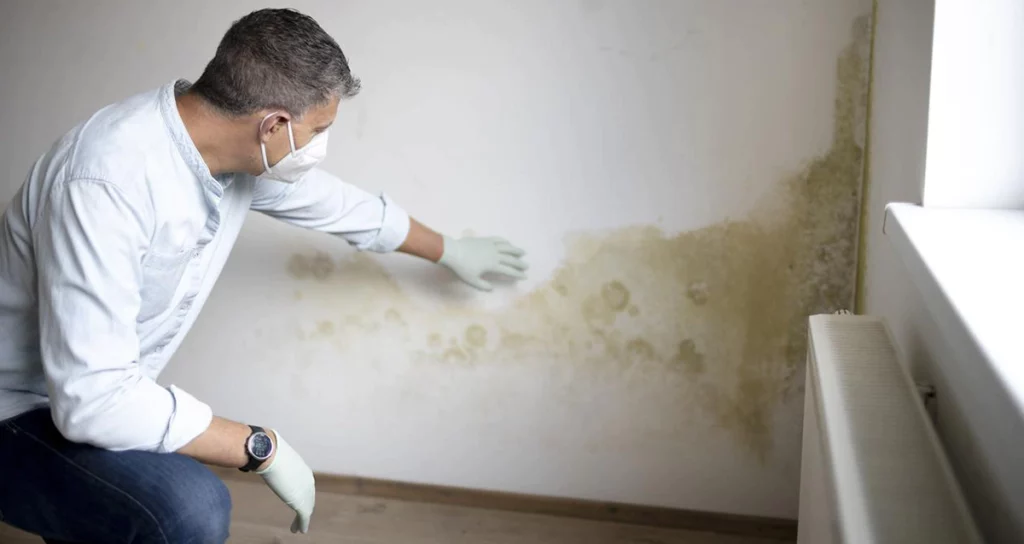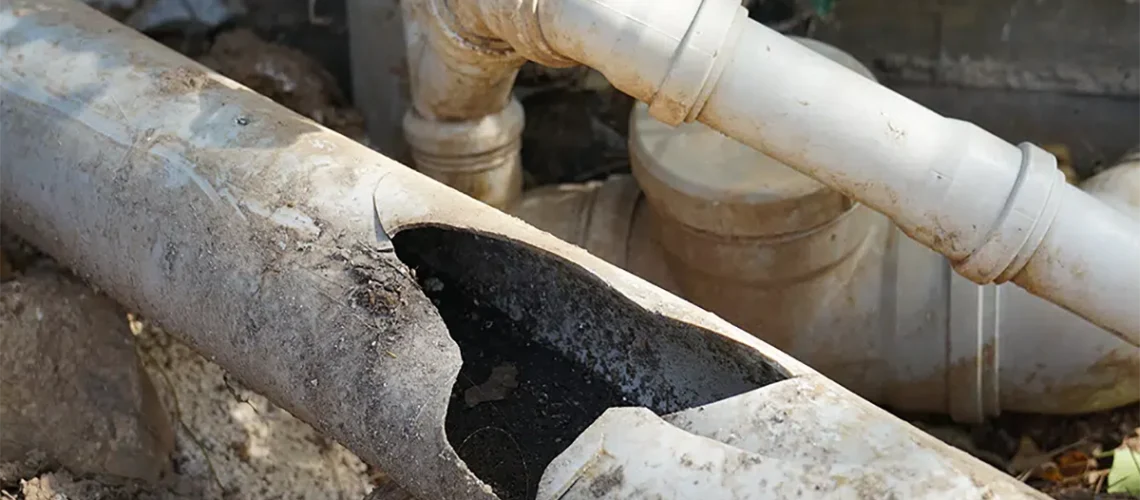A functioning sewer line is essential for the proper functioning of your home’s plumbing system. However, over time, sewer lines can deteriorate due to various factors, leading to a range of issues that can cause inconvenience and potential health hazards. Recognizing the signs of a broken sewer line is crucial to addressing the problem promptly and preventing further damage. In this comprehensive article, we will explore the common broken sewer line symptoms and discuss the necessary steps for repair and replacement.
Contents
What Causes a Sewer Line to Break?
A broken sewer line doesn’t happen overnight. Understanding what leads to a damaged sewer line can help you prevent major plumbing issues and costly repairs. Here are the most common causes of a broken sewer pipe:
- Tree Root Infiltration
Roots from trees and shrubs naturally seek moisture, and your underground sewer pipes provide a perfect source. Over time, roots can penetrate tiny cracks in the pipe and expand inside, blocking or breaking the line. - Aging and Deterioration
Many older homes still rely on clay, cast iron, or Orangeburg pipes. These materials degrade over time, becoming brittle and more prone to cracks or collapse. A broken sewer is often the result of decades of wear and tear. - Shifting Soil and Ground Movement
Natural settling, soil erosion, or nearby construction can cause the ground to shift. This pressure may crack, dislodge, or break the sewer line, especially if it’s already weakened. - Extreme Temperature Changes
Sudden freezing and thawing cycles can put stress on underground pipes. In colder climates, frozen wastewater can expand and cause the pipe to burst. - Poor Installation or Design
If your sewer line was not installed with the proper slope or secure joints, it’s more vulnerable to sagging (called a “belly”) and eventual breakage. - Heavy Surface Loads
Parking heavy vehicles or installing structures like patios directly above sewer lines can compress the soil and damage the pipe beneath.
Recognizing the underlying cause is just as important as spotting the symptoms. A professional plumber can inspect the line and recommend the best solution—whether it’s repair or full replacement.
How to Know If Your Sewer Line Is Broken: At-Home Tests
Wondering how to know if your sewer line is broken without calling a plumber right away? While professional inspections provide the most accurate diagnosis, there are a few simple tests and observations you can try at home to detect early signs of a broken sewer line or damaged sewer pipe:
- Test Multiple Drains
Flush toilets, run sinks, and drain tubs one after another. If more than one fixture shows signs of slow drainage or bubbling, it’s a likely indicator of a sewer line issue, not just a local clog. - Dye Testing
Add a few drops of food coloring to a toilet bowl and flush. If you notice colored water or wet patches in your yard or near the foundation within 30–60 minutes, it could be leaking from a cracked or broken sewer line. - Smell Check
Step outside and walk near the sewer cleanout or along the line’s path. A strong sewage smell outdoors—especially on dry days—can signal a break in the line below. - Observe Lawn Conditions
Are parts of your yard unusually green, soggy, or sunken compared to others? These can be signs of a damaged sewer line leaking nutrients and moisture underground. - Listen for Gurgling Noises
Strange gurgling or bubbling sounds in your drains after flushing or using water suggest trapped air—a symptom of a partially blocked or broken sewer pipe.
While these DIY checks can help identify red flags, they are not substitutes for a licensed inspection. If you notice multiple warning signs, it’s time to call a plumber for a camera inspection or further testing.
Signs Your Sewer Line is Broken
Detecting a broken sewer line early is essential to prevent further damage and costly repairs. If you’re wondering how do you know if your sewer line is broken, there are several telltale signs to watch out for:
There are Moldy Areas on the Walls and Floors
One of the most noticeable signs of a broken sewer line is the presence of mold and mildew on your walls and floors. The excess moisture escaping from the sewer line can create a conducive environment for mold growth. If you notice damp or moldy patches, especially in areas near plumbing fixtures, it’s a strong indication of a sewer line issue.

Slow Drains
Slow drainage in sinks, tubs, and toilets is a common symptom of a broken sewer line. When a sewer line is compromised, water and waste materials cannot flow freely, leading to sluggish draining. If you’re experiencing slow drains in multiple areas of your home, it’s time to investigate the health of your sewer line.
Weird Smell
A distinctive, foul odor resembling sewage is a clear sign that your sewer line might be broken. This broken sewer line smell is often most noticeable in the vicinity of drains and can be particularly unpleasant. If you detect an unusual smell in your home or yard, it’s essential to consider the possibility of a sewer line issue.
Crawlers and Critters
Broken sewer lines can attract pests and critters due to the presence of waste materials. Rats, roaches, and other pests are drawn to the damp and unhygienic environment created by a compromised sewer line. If you notice an increase in pest activity around your property, it’s worth investigating the status of your sewer line.
Sinking Concrete Slabs
If your property has concrete pathways or slabs, a broken sewer line beneath them can lead to sinking or uneven surfaces. The wastewater escaping from the damaged line can erode the soil, causing structural issues in your outdoor spaces.
Cracks in Your Foundation
A broken sewer line can contribute to soil erosion around your home’s foundation, leading to cracks in the foundation itself. These cracks can affect the stability and structural integrity of your house. If you observe any cracks in your foundation walls, it’s advisable to consider a sewer line inspection.
Is a Broken Sewer Pipe an Emergency?
Yes — in most cases, a broken sewer pipe is considered a plumbing emergency. Even if the issue seems minor at first, ignoring it can quickly lead to serious health, safety, and structural consequences. Here’s why you should treat signs of a broken sewer pipe with urgency:
- Health Hazards
A broken sewer pipe can release raw sewage into your home or yard. This creates a serious biohazard, exposing you and your family to harmful bacteria, viruses, and parasites. - Water Damage and Mold
Sewage leaks often go unnoticed behind walls or under flooring. Over time, this moisture promotes mold growth and damages wood, drywall, and insulation — adding costly remediation on top of plumbing repairs. - Foundation Risks
A leaking or damaged sewer line beneath your home can erode the surrounding soil, weakening your foundation. If left untreated, this could cause cracks, shifting, or sinking. - Pest Infestation
A broken pipe provides the perfect environment for rats, insects, and other pests to enter your home through drain lines or access points in the yard. - Code Violations and Liability
In many cities, untreated sewer line issues can violate local health or building codes. You may also be held responsible for damage to shared sewer systems or neighboring properties.
While not all symptoms mean immediate disaster, it’s always better to act fast. If you suspect a break — especially if you smell sewage, see yard flooding, or hear drain gurgling — contact a licensed plumber right away. Quick action can reduce repair costs and protect your home from long-term damage.
Sewer Line Repair and Replacement
When you’ve identified the symptoms of a broken sewer line, it’s essential to take action promptly to avoid worsening the situation. Depending on the extent of the damage, you may need to consider either repair or replacement options. Here’s what you need to know:

- Patch Repairs: For minor cracks or localized damage, patch repairs can be a suitable solution. Plumbers can use specialized materials to seal the affected area, preventing leaks and restoring the integrity of the sewer line.
- Hydro Jetting: Hydro jetting involves using a high-pressure stream of water to clear out debris, blockages, and buildup within the sewer line. This method can help improve the flow and function of the line without the need for extensive excavation.
- Pipe Lining: Pipelining, also known as trenchless repair, is a non-invasive method that involves inserting a resin-coated liner into the damaged pipe. Once in place, the liner hardens and creates a new, structurally sound inner lining within the existing pipe.
Repairing a broken sewer line involves fixing specific sections or patching up minor cracks. Replacement, on the other hand, entails removing the old sewer line and installing a new one. It’s crucial to consult with a professional plumber to assess the situation accurately and determine the best course of action.
In conclusion, recognizing the symptoms of a broken sewer line is vital for maintaining the functionality and hygiene of your home. If you experience any of the mentioned signs, it’s recommended to seek professional assistance to address the issue promptly and effectively. Regular maintenance and timely repairs can help prevent extensive damage and ensure the smooth operation of your plumbing system.
FAQ about the symptoms of a broken sewer line
Early signs of a sewer line issue include slow drains, gurgling noises, and sewage odors in your home.
Minor sewer line issues shouldn’t be ignored, as they can worsen over time and potentially lead to more extensive damage.
If you’re unsure about a sewer line problem, it’s wise to contact a professional plumber for a thorough inspection and accurate diagnosis.
Delaying repairs on a broken sewer pipe can lead to worsening damage, including foundation issues, mold, and exposure to raw sewage. It’s best to schedule an inspection as soon as you notice symptoms.
The most common symptom is a strong sewage odor coming from drains, your yard, or basement. This smell is often one of the first and most obvious signs that your sewer line is broken.



